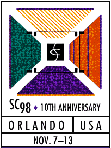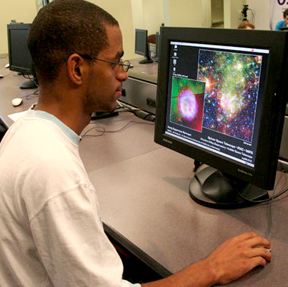H.S. students, teachers to learn modeling, simulation skills
Ohio’s first STEM Academy in Computational Science and Engineering is underway, providing select high school students and teachers with valuable skills in simulation and modeling.
Since 1987, OSC has been providing our clients services in four areas, or functions:
Supercomputing. OSC provides the computational power and storage that scientists need to meet their research goals. Whether researchers need to harness the incredible power of a parallel processor cluster to better understand deep space, a vector processor machine to do weather modeling, or a mid-size shared memory processor system to model the human heart, OSC has the hardware and software solutions to meet their needs.
Research. A staff of high performance computing and networking research experts maintain active research programs in HPC and Networking, Homeland Security and Defense, Environmental Sciences, Engineering and Life Sciences. Our goals are to lead science and engineering research efforts, assist researchers with custom needs and collaborate with regional, national and international researchers in groundbreaking initiatives.
Education. OSC has a national reputation for its training and education programs. Staff teach faculty and student researchers through scientific computing workshops, one-on-one classes, and web-based portal training. Ohio students gain exposure to the world of high performance computing and networking during our annual summer institutes for young women in middle school and for junior and senior high school students. And, the statewide, virtual Ralph Regula School of Computational Science coordinates computational science and engineering education activities for all levels of learning.
Cyberinfrastructure. The Ohio Supercomputer Center’s cyberinfrastructure and software development researchers provide the user community with various high performance computing software options. This variety enables researchers to select parallel computing languages they most prefer, and just as important, it creates a test bed for exploring these systems. By taking a holistic approach to generating efficient supercomputing applications for researchers, the Center’s cyberinfrastructure and software development research capitalizes on all the components within the cycle of innovation — development, experimentation, and analysis - and continuously improves the services provided.
Ohio’s first STEM Academy in Computational Science and Engineering is underway, providing select high school students and teachers with valuable skills in simulation and modeling.
OSC participated in the first-ever National Internet2 Day on March 18. This nationwide virtual event consisted of nearly 40 leading research universities from across the country, including four major Ohio institutions: The Ohio State University, University of Toledo, Case Western Reserve University, and University of Cincinnati.
Ohio is in good hands if State Science Day resembles any indication of the future.
Joseph M. Kessler, a junior at Carroll High School, received the Ohio Supercomputer Center (OSC) Award for his exceptional project entered at State Science Day 1999. Kessler was one of three students chosen for this prestigious award.
In an effort to create better trained surgeons, teaching professor Dr. Gregory Wiet and the Ohio Supercomputer Center have been working on a project known as the Validation Dissemination of Temporal Bone Dissection that looks at simulating surgery through computer visualization, applied force, and even changes in sound. Future surgeons are using this technology that allows for direct consequences to action and gives them opportunities to experience problems that may occur in a real surgery that they must react to quickly.
For more information, contact:
Leslie Southern
OSC Director of High Performance Computing
614-292-9367
leslie@osc.edu
 The Ohio Supercomputer Center (OSC) will present Collaborations for the 21st Century -- a showcase of projects setting the tone for Ohio's future in high performance computing and communications -- at SC98: High Performance Networking and Computing, Nov. 7-13, in Orlando.
The Ohio Supercomputer Center (OSC) will present Collaborations for the 21st Century -- a showcase of projects setting the tone for Ohio's future in high performance computing and communications -- at SC98: High Performance Networking and Computing, Nov. 7-13, in Orlando.

A Summer Academy in Computational Science and Engineering will teach sophisticated computer modeling and simulation skills to 40 Ohio high school students and ten teachers, thanks to a grant announced today by the Ohio Board of Regents.
For more information, contact:
Jennifer Teig von Hoffman
Boston University AGTP Lead
(617) 358-0033
jtvh@bu.edu
Access News Release -- February 11, 2004 -- The Ohio Supercomputer Center (OSC), along with three state medical centers, has received $350,000 for pediatric cancer research as part of the federal FY2004 Omnibus Appropriations bill.
James Estep and Christopher Lewis, both computer science majors at Shawnee State University, put their knowledge of computers to the test this summer. The Portsmouth residents spent eight weeks at the Ohio Supercomputer Center (OSC) in Columbus learning about high performance networking.
"The experience we had this summer is definitely something we would not be able to learn in the classroom," Estep said. "I learned valuable organization and research skills, and a lot about advanced technologies."
As one of the esteemed scientists working with the Intergovernmental Panel on Climate Change (IPCC), David Bromwich’s research — conducted, in part, at the Ohio Supercomputer Center — on the changes in polar atmospheric circulation and Antarctic climate variability contributed to winning this year’s Nobel Peace Prize.